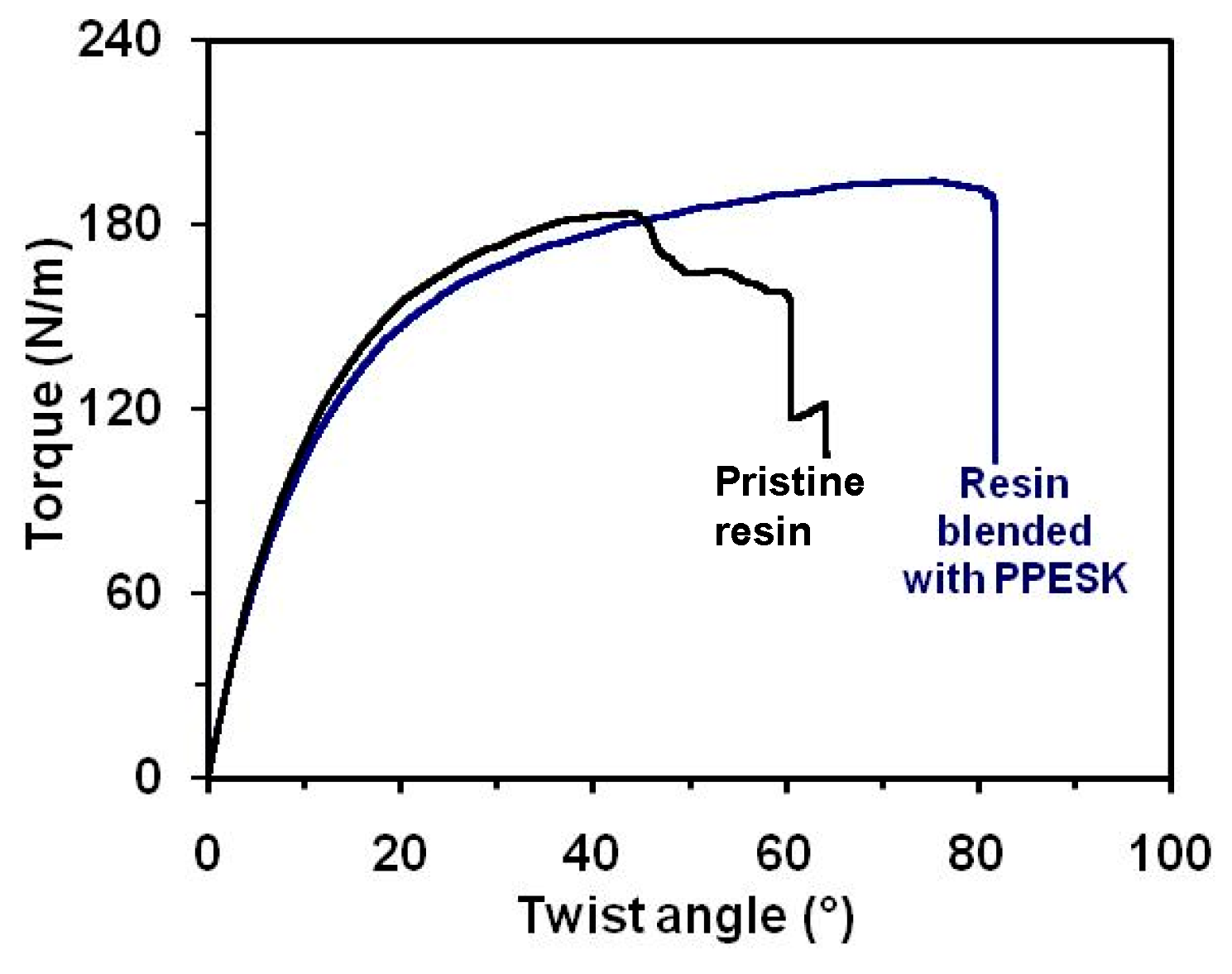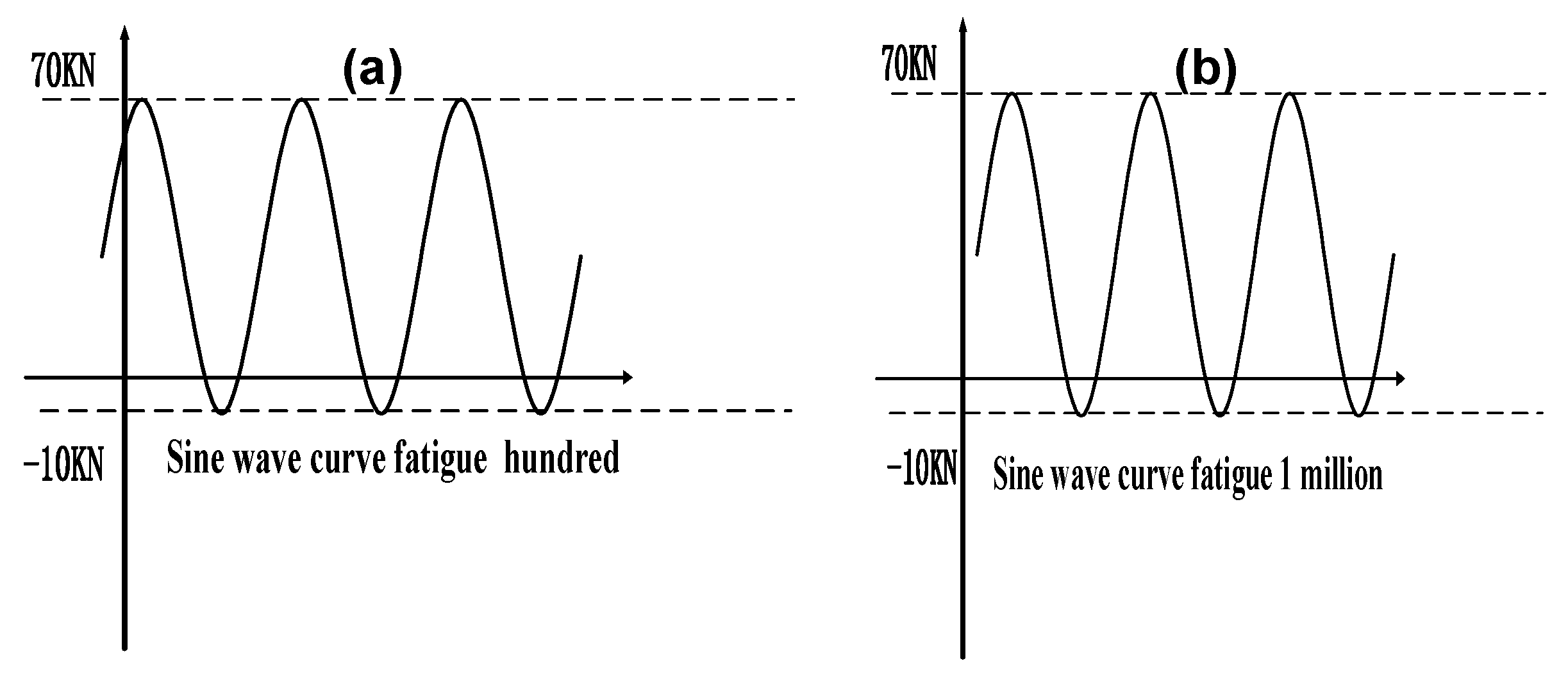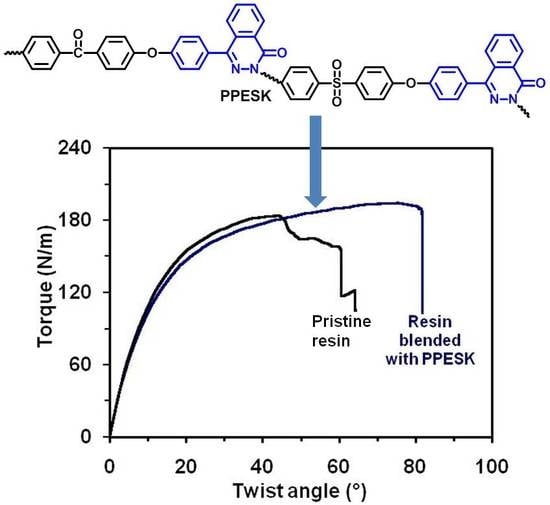PPESK-Modified Multi-Functional Epoxy Resin and Its Application to the Pultrusion of Carbon Fiber
Abstract
:1. Introduction
2. Materials and Methods
2.1. Materials
2.2. Preparation of Samples
2.3. Characterization
3. Results
3.1. Curing Behavior and Viscosity of E/PPESK Resin Blends
3.2. Mechanical Properties of E/PPESK Resin Blends
3.3. Physical Properties of CF/E/PPESK Epoxy Resin Composites
3.4. Mechanical Properties of CF/E/PPESK Epoxy Resin Composites
3.5. Fatigue and Aging Properties of CF/E/PPESK Composites
4. Conclusions
Author Contributions
Funding
Acknowledgments
Conflicts of Interest
References
- Park, S.Y.; Choi, W.J.; Choi, C.H.; Choi, H.S. The effect of curing temperature on thermal, physical and mechanical characteristics of two types of adhesives for aerospace structures. J. Adhes. Sci. Technol. 2018, 32, 1200–1223. [Google Scholar] [CrossRef]
- Xu, Y.J.; Liao, G.X.; Gu, T.S.; Zheng, L.; Jian, X.G. Mechanical and morphological properties of epoxy resins modified by poly(phthalazinone ether sulfone ketone). J. Appl. Polym. Sci. 2008, 110, 2253–2260. [Google Scholar] [CrossRef]
- Auvergne, R.; Caillol, S.; David, G.; Boutevin, B.; Pascault, J.P. Biobased thermosetting epoxy: Present and future. Chem. Rev. 2014, 114, 1082–1115. [Google Scholar] [CrossRef] [PubMed]
- Kumar, S.; Krishnan, S.; Samal, S.K.; Mohanty, S.; Nayak, S.K. Toughening of petroleum based (DGEBA) epoxy resins with various renewable resources based flexible chains for high performance application: A review. Ind. Eng. Chem. Res. 2018, 57, 2711–2726. [Google Scholar] [CrossRef]
- Thunga, M.; Akinc, M.; Kessler, M.R. Tailoring the toughness and CTE of high temperature bisphenol E cyanate ester (BECy) resin. Express Polym. Lett. 2014, 8, 336–344. [Google Scholar] [CrossRef]
- Marouf, B.T.; Mai, Y.W.; Bagheri, R.; Pearson, R.A. Toughening of epoxy nanocomposites: Nano and hybrid effects. Polym. Rev. 2016, 56, 70–112. [Google Scholar] [CrossRef]
- Wu, S.Y.; Guo, Q.P.; Kraska, M.; Stuhn, B.; Mai, Y.W. Toughening epoxy thermosets with block ionomers: The role of phase domain size. Macromolecules. 2013, 46, 8190–8202. [Google Scholar] [CrossRef]
- Fernandez, B.; Arbelaiz, A.; Diaz, E.; Mondragon, I. Influence of polyethersulfone modification of a tetrafunctional epoxy matrix on the fracture behavior of composite laminates based on woven carbon fibers. Polym. Compos. 2004, 25, 480–488. [Google Scholar] [CrossRef]
- Chen, C.H.; Chen, P.H. Hybrid fibre reinforced epoxy composites for pultrusion: Mechanical and thermal properties. Polym. Polym. Compos. 2011, 19, 459–468. [Google Scholar] [CrossRef]
- Li, G.; Huang, Z.B.; Li, P.; Xin, C.L.; Jia, X.L.; Wang, B.H.; He, Y.D.; Ryu, S.; Yang, X.P. Curing kinetics and mechanism of polysulfone nanofibrous membranes toughened epoxy/amine systems using isothermal DSC and NIR. Thermochim. Acta 2010, 497, 27–34. [Google Scholar] [CrossRef]
- Zhang, J.; Guo, Q.P.; Fox, B.L. Study on thermoplastic-modified multifunctional epoxies: Influence of heating rate on cure behavior and phase separation. Compos. Sci. Technol. 2009, 68, 1172–1179. [Google Scholar] [CrossRef]
- Giannotti, M.I.; Bernal, C.R.; Oyanguren, P.A.; Galante, M.J. Morphology and fracture properties relationship of epoxy-diamine systems simultaneously modified with polysulfone and poly(ether imide). Polym. Eng. Sci. 2005, 45, 1312–1318. [Google Scholar] [CrossRef]
- Hourston, D.J.; Lane, J.M.; Zhang, H.X. Toughening of epoxy resins with thermoplastics: 3. An investigation into the effects of composition on the properties of epoxy resin blends. Polym. Int. 1997, 42, 349–355. [Google Scholar] [CrossRef]
- Chen, H.M.; Lv, R.G.; Liu, P.; Wang, H.Y.; Huang, Z.Y.; Huang, T.; Li, T.S. An investigation of cure and thermal stability of poly(amide-amidic acid) modified tetraglycidyl 4,4′-diaminodiphenylmethane/4,4′-diaminodiphenylsulfone. J. Appl. Polym. Sci. 2013, 128, 1592–1600. [Google Scholar] [CrossRef]
- Zhong, Z.K.; Zheng, S.X.; Huang, J.Y.; Cheng, X.G.; Guo, Q.P.; Wei, J. Phase behavior and mechanical properties of epoxy resin containing phenolphthalein poly(ether ether ketone). Polymer 1998, 39, 1075–1080. [Google Scholar] [CrossRef]
- Luo, Y.; Zhang, M.; Dang, G.D.; Li, Y.; An, X.F.; Chen, C.H.; Yi, X.S. Toughening of epoxy resin by poly(ether ether ketone) with pendant fluorocarbon groups. J. Appl. Polym. Sci. 2011, 122, 1758–1765. [Google Scholar] [CrossRef]
- Banea, M.D.; da Silva, L.F.M.; Campilho, R.D.S.G. Effect of temperature on the shear strength of aluminium single lap bonded joints for high temperature applications. J. Adhes. Sci. Technol. 2012, 28, 1367–1381. [Google Scholar] [CrossRef] [Green Version]
- Liu, R.; Wang, J.Y.; Li, J.L.; Jian, X.G. An investigation of epoxy/thermoplastic blends based on addition of a novel coply(aryl ether nitrile) containing phthalazinone and biphenyl moieties. Polym. Int. 2015, 64, 1786–1793. [Google Scholar] [CrossRef]
- Xu, Y.J.; Fu, X.J.; Liao, G.X.; Zhou, H.X.; Jian, X.G. Preparation, morphology and thermo-mechanical properties of epoxy resins modified by co-poly(phthalazinone ether sulfone). High Perform. Polym. 2011, 23, 248–254. [Google Scholar] [CrossRef]
- Liu, R.; Wang, J.Y.; He, Q.Z.; Zong, L.S.; Jian, X.G. Interaction and properties of epoxy-amine system modified with poly(phthalazinone ether nitrile ketone). J. Appl. Polym. Sci. 2016, 133, 42938. [Google Scholar] [CrossRef]
- Wang, L.W.; Wang, J.W.; Qi, Y.; Zhang, F.F.; Weng, Z.H.; Jian, X.G. Preparation of novel epoxy resin bearing phthalazinone moiety and their application as high-temperature adhesives. Polymers 2018, 10, 708. [Google Scholar] [CrossRef]
- Wang, J.Y.; Wang, M.J.; Liu, C.; Zhou, H.X.; Jian, X.G. Synthesis of poly(arylene ether nitrile ketone)s bearing phthalazinone moiety and their properties. Polym. Bull. 2013, 70, 1467–1481. [Google Scholar] [CrossRef]
- Song, Y.; Wang, J.Y.; Li, G.H.; Sun, Q.M.; Jian, X.G.; Teng, J.; Zhang, H.B. Synthesis, characterization and optical properties of cross-linkable poly(phthalazinone ether ketone sulfone). Polymer 2008, 49, 724–731. [Google Scholar] [CrossRef]











| Phase 1 (°C) | Phase 2 (°C) | Phase 3 (°C) | Mold Length (m) | Pultrusion Rate (m/min) | Resin Content (%) |
|---|---|---|---|---|---|
| 170 | 180 | 195 | 0.9–1.2 | 0.4–0.6 | 20–24 |
| Samples | Glass Transition Temperature (°C) | Initial Decomposition Temperature (°C) | Maximum Weight Loss Temperature (°C) |
|---|---|---|---|
| E/PPESK-0 | 225 | 385 | 420 |
| E/PPESK-2 | 226 | 386 | 421 |
| E/PPESK-4 | 230 | 387 | 425 |
| E/PPESK-6 | 232 | 385 | 417 |
| E/PPESK-8 | 235 | 386 | 421 |
| Properties | CF/E | CF/E/PPESK-6 |
|---|---|---|
| Tensile strength (MPa) | 2300 ± 142 | 2200 ± 153 |
| Linear expansion coefficient | ≤2.0 × 10−6 | ≤2.0 × 10−6 |
| Interlaminar shear strength (MPa) | 82.7 ± 4.8 | 81.6 ± 4.2 |
| 30 KN radial pressure resistance | No cracking or peeling | No cracking or peeling |
| Bending performance, 55D (D: bar diameter) | No cracking or peeling on the surface below 55D | No cracking or peeling on the surface at 55 D |
| High temperature tensile strength | Tensile strength at 190 °C ≥ the value of 90% at room temperature | Tensile strength at 190 °C ≥ the value of 90% at room temperature |
| Cycles | Pull Force (kN) | Downward Force (kN) | Upward Displacement (mm) | Downward Displacement (mm) |
|---|---|---|---|---|
| 3183 | 70.034 | −9.961 | 0.942 | 0.134 |
| 6410 | 70.025 | −10.044 | 0.96 | 0.131 |
| 142,036 | 70.025 | −10.044 | 0.96 | 0.131 |
| 513,257 | 69.425 | −10.044 | 0.98 | 0.132 |
| 784,601 | 69.925 | −9.844 | 0.94 | 0.139 |
| 1,025,732 | 70.0855 | −10.144 | 0.97 | 0.142 |
© 2018 by the authors. Licensee MDPI, Basel, Switzerland. This article is an open access article distributed under the terms and conditions of the Creative Commons Attribution (CC BY) license (http://creativecommons.org/licenses/by/4.0/).
Share and Cite
Wang, L.; Wang, J.; Zhang, F.; Qi, Y.; Weng, Z.; Jian, X. PPESK-Modified Multi-Functional Epoxy Resin and Its Application to the Pultrusion of Carbon Fiber. Polymers 2018, 10, 1067. https://doi.org/10.3390/polym10101067
Wang L, Wang J, Zhang F, Qi Y, Weng Z, Jian X. PPESK-Modified Multi-Functional Epoxy Resin and Its Application to the Pultrusion of Carbon Fiber. Polymers. 2018; 10(10):1067. https://doi.org/10.3390/polym10101067
Chicago/Turabian StyleWang, Liwei, Jinyan Wang, Fengfeng Zhang, Yu Qi, Zhihuan Weng, and Xigao Jian. 2018. "PPESK-Modified Multi-Functional Epoxy Resin and Its Application to the Pultrusion of Carbon Fiber" Polymers 10, no. 10: 1067. https://doi.org/10.3390/polym10101067






